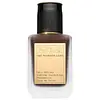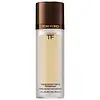What's inside
What's inside
 Key Ingredients
Key Ingredients

 Benefits
Benefits

 Concerns
Concerns

 Ingredients Side-by-side
Ingredients Side-by-side

Water
Skin ConditioningCyclopentasiloxane
EmollientIsododecane
EmollientAlcohol
AntimicrobialGlycerin
HumectantPhenyl Trimethicone
Skin ConditioningIpdi/Di-C12-13 Alkyl Tartrate/Bis-Hydroxyethoxypropyl Dimethicone Copolymer
Aluminum Starch Octenylsuccinate
AbsorbentCetyl PEG/PPG-10/1 Dimethicone
EmulsifyingPolyglyceryl-4 Isostearate
EmulsifyingDisteardimonium Hectorite
StabilisingSodium Chloride
MaskingAluminum Hydroxide
EmollientBenzimidazole Diamond Amidoethyl Urea Carbamoyl Propyl Polymethylsilsesquioxane
Cosmetic ColorantCaprylic/Capric Triglyceride
MaskingDi-C12-13 Alkyl Tartrate
EmollientDisodium Stearoyl Glutamate
CleansingHexyl Laurate
EmollientPentaerythrityl Tetra-Di-T-Butyl Hydroxyhydrocinnamate
AntioxidantRubus Idaeus Leaf Cell Culture
Skin ConditioningPotassium Sorbate
PreservativeSodium Dehydroacetate
PreservativeCI 77891
Cosmetic ColorantIron Oxides
Water, Cyclopentasiloxane, Isododecane, Alcohol, Glycerin, Phenyl Trimethicone, Ipdi/Di-C12-13 Alkyl Tartrate/Bis-Hydroxyethoxypropyl Dimethicone Copolymer, Aluminum Starch Octenylsuccinate, Cetyl PEG/PPG-10/1 Dimethicone, Polyglyceryl-4 Isostearate, Disteardimonium Hectorite, Sodium Chloride, Aluminum Hydroxide, Benzimidazole Diamond Amidoethyl Urea Carbamoyl Propyl Polymethylsilsesquioxane, Caprylic/Capric Triglyceride, Di-C12-13 Alkyl Tartrate, Disodium Stearoyl Glutamate, Hexyl Laurate, Pentaerythrityl Tetra-Di-T-Butyl Hydroxyhydrocinnamate, Rubus Idaeus Leaf Cell Culture, Potassium Sorbate, Sodium Dehydroacetate, CI 77891, Iron Oxides
Methyl Trimethicone
Skin ConditioningWater
Skin ConditioningDimethicone
EmollientCaprylic/Capric Triglyceride
MaskingIsocetyl Alcohol
EmollientButylene Glycol
HumectantLauryl PEG-9 Polydimethylsiloxyethyl Dimethicone
Skin ConditioningPEG/PPG-18/18 Dimethicone
EmulsifyingPolymethyl Methacrylate
Trimethylsiloxysilicate
EmollientDimethicone/Vinyl Dimethicone Crosspolymer
Skin ConditioningPhenyl Trimethicone
Skin ConditioningHdi/PPG/Polycaprolactone Crosspolymer
Sodium Hyaluronate
HumectantSilybum Marianum Extract
Skin ConditioningLaminaria Saccharina Extract
Skin ProtectingCorallina Officinalis Extract
Skin ConditioningSigesbeckia Orientalis Extract
Skin ConditioningCucumis Sativus Fruit Extract
EmollientTetrahexyldecyl Ascorbate
AntioxidantAcetyl Hexapeptide-8
HumectantCaffeine
Skin ConditioningLactis Proteinum
Skin ConditioningYeast Extract
Skin ConditioningTocopheryl Linoleate/Oleate
AntioxidantGlycerin
HumectantTrehalose
HumectantMethicone
EmollientCaprylyl Glycol
EmollientSaccharomyces Lysate Extract
HumectantPropylene Glycol Dicaprate
EmollientHelianthus Annuus Seed Extract
Skin ConditioningLavandula Angustifolia Oil
MaskingAcetyl Glucosamine
Skin ConditioningCholesterol
EmollientHordeum Vulgare Extract
EmollientGlycine Soja Protein
EmulsifyingSilica
AbrasiveLecithin
EmollientSodium Chloride
MaskingMagnesium Aluminum Silicate
AbsorbentDisteardimonium Hectorite
StabilisingLauryl Methyl Gluceth-10 Hydroxypropyldimonium Chloride
Dimethicone Silylate
Xanthan Gum
EmulsifyingPEG-4 Dilaurate
EmulsifyingCalcium Chloride
AstringentLinalool
PerfumingBHT
AntioxidantDisodium EDTA
Potassium Sorbate
PreservativePhenoxyethanol
PreservativeCI 77891
Cosmetic ColorantCI 77492
Cosmetic ColorantCI 77491
Cosmetic ColorantCI 77499
Cosmetic ColorantMethyl Trimethicone, Water, Dimethicone, Caprylic/Capric Triglyceride, Isocetyl Alcohol, Butylene Glycol, Lauryl PEG-9 Polydimethylsiloxyethyl Dimethicone, PEG/PPG-18/18 Dimethicone, Polymethyl Methacrylate, Trimethylsiloxysilicate, Dimethicone/Vinyl Dimethicone Crosspolymer, Phenyl Trimethicone, Hdi/PPG/Polycaprolactone Crosspolymer, Sodium Hyaluronate, Silybum Marianum Extract, Laminaria Saccharina Extract, Corallina Officinalis Extract, Sigesbeckia Orientalis Extract, Cucumis Sativus Fruit Extract, Tetrahexyldecyl Ascorbate, Acetyl Hexapeptide-8, Caffeine, Lactis Proteinum, Yeast Extract, Tocopheryl Linoleate/Oleate, Glycerin, Trehalose, Methicone, Caprylyl Glycol, Saccharomyces Lysate Extract, Propylene Glycol Dicaprate, Helianthus Annuus Seed Extract, Lavandula Angustifolia Oil, Acetyl Glucosamine, Cholesterol, Hordeum Vulgare Extract, Glycine Soja Protein, Silica, Lecithin, Sodium Chloride, Magnesium Aluminum Silicate, Disteardimonium Hectorite, Lauryl Methyl Gluceth-10 Hydroxypropyldimonium Chloride, Dimethicone Silylate, Xanthan Gum, PEG-4 Dilaurate, Calcium Chloride, Linalool, BHT, Disodium EDTA, Potassium Sorbate, Phenoxyethanol, CI 77891, CI 77492, CI 77491, CI 77499
Ingredients Explained
These ingredients are found in both products.
Ingredients higher up in an ingredient list are typically present in a larger amount.
This ingredient is an emollient, solvent, and texture enhancer. It is considered a skin-softener by helping the skin prevent moisture loss.
It helps thicken a product's formula and makes it easier to spread by dissolving clumping compounds.
Caprylic Triglyceride is made by combining glycerin with coconut oil, forming a clear liquid.
While there is an assumption Caprylic Triglyceride can clog pores due to it being derived from coconut oil, there is no research supporting this.
Learn more about Caprylic/Capric TriglycerideCi 77891 is a white pigment from Titanium dioxide. It is naturally found in minerals such as rutile and ilmenite.
It's main function is to add a white color to cosmetics. It can also be mixed with other colors to create different shades.
Ci 77891 is commonly found in sunscreens due to its ability to block UV rays.
Learn more about CI 77891Disteardimonium Hectorite comes from the clay mineral named hectorite. It is used to add thickness to a product.
It can also help stabilize a product by helping to disperse other ingredients.
Hectorite is a rare, white clay mineral.
Learn more about Disteardimonium HectoriteGlycerin is already naturally found in your skin. It helps moisturize and protect your skin.
A study from 2016 found glycerin to be more effective as a humectant than AHAs and hyaluronic acid.
As a humectant, it helps the skin stay hydrated by pulling moisture to your skin. The low molecular weight of glycerin allows it to pull moisture into the deeper layers of your skin.
Hydrated skin improves your skin barrier; Your skin barrier helps protect against irritants and bacteria.
Glycerin has also been found to have antimicrobial and antiviral properties. Due to these properties, glycerin is often used in wound and burn treatments.
In cosmetics, glycerin is usually derived from plants such as soybean or palm. However, it can also be sourced from animals, such as tallow or animal fat.
This ingredient is organic, colorless, odorless, and non-toxic.
Glycerin is the name for this ingredient in American English. British English uses Glycerol/Glycerine.
Learn more about GlycerinPhenyl Trimethicone is a silicon-based polymer. It is derived from silica.
Phenyl Trimethicone is used as an emollient and prevents products from foaming.
As an emollient, it helps trap moisture in the skin. It is considered an occlusive.
Learn more about Phenyl TrimethiconePotassium Sorbate is a preservative used to prevent yeast and mold in products. It is commonly found in both cosmetic and food products.
This ingredient comes from potassium salt derived from sorbic acid. Sorbic acid is a natural antibiotic and effective against fungus.
Both potassium sorbate and sorbic acid can be found in baked goods, cheeses, dried meats, dried fruit, ice cream, pickles, wine, yogurt, and more.
You'll often find this ingredient used with other preservatives.
Learn more about Potassium SorbateChances are, you eat sodium chloride every day. Sodium Chloride is also known as table salt.
This ingredient has many purposes in skincare: thickener, emulsifier, and exfoliator.
You'll most likely find this ingredient in cleansers where it is used to create a gel-like texture. As an emulsifier, it also prevents ingredients from separating.
There is much debate on whether this ingredient is comedogenic. The short answer - comedogenic ratings don't tell the whole story. Learn more about comegodenic ratings here.
The concensus about this ingredient causing acne seems to be divided. Research is needed to understand if this ingredient does cause acne.
Scrubs may use salt as the primary exfoliating ingredient.
Learn more about Sodium ChlorideWater. It's the most common cosmetic ingredient of all. You'll usually see it at the top of ingredient lists, meaning that it makes up the largest part of the product.
So why is it so popular? Water most often acts as a solvent - this means that it helps dissolve other ingredients into the formulation.
You'll also recognize water as that liquid we all need to stay alive. If you see this, drink a glass of water. Stay hydrated!
Learn more about Water